Chapter 7
THE POISON BUILDS UP
"There's a Virus
in our Bloodstream"
~~~ continued
|
|
was discovered to have sent a death threat to Reagan,(31)
somehow it seemed appropriate to our group-fantasy that
Reagan-and America-was being poisoned.
By the end of 1982, there were so many poison alerts that it
seemed as though America had become a giant Jonestown. More
poison Tylenol was discovered in Illinois; cyanide was found in
Anacin tablets in California; in Colorado, someone put mercuric
chloride into Excedrin tablets and rat poison into Anacin
capsules; in Wyoming, hydrochloric acid was found in Visene eye
drops; in Minneapolis, sodium hydroxide was put into chocolate
milk; in Louisiana, one town found cyanide in its water supply;
in Florida, someone put insecticide into an orange juice
container.(32)
By Halloween, literally hundreds of people were swept up into
acting out the group-fantasy, this time on children begging for
candy in "trick or treat" visits. Stimulated by
newspaper headlines such as "TRICK OR TERROR-Nationwide
Poison Candy Alert: Keep Kids At Home,"(33) impulse-ridden
individuals put hundreds of different poisons into candy, Demerol
into cookies, pins into apples and razor blades into frankfurters
in order to make our internal fears concrete. Russell Baker
captured the feeling of The Great Reagan Poison Alert in his New
York Times col-umn:
For five weeks I traveled across beautiful autumnal
America. It was like a booby hatch of the criminally insane.
In Detroit they were finding razor blades in hot dogs sold
at the grocery. In California somebody had laced eyewash with
corrosive chemicals. In Chicago, capsules sold as headache
remedies came packed with cyanide. In New York and its
suburbs, not to be outdone, people spent the weekend
inserting needles and pins into candy they planned to give
children on Halloween.
I was struck by the sense of encroaching madness . . .(35)
Like Frosch's paranoid patient, descending into the depths of
his psychosis, Reagan's America felt surrounded by poisoners -
only in our group-fantasy we delegated concrete poisoning
episodes to impulsive individuals within the nation to make our
feelings seem more "real."
For the next three months, the news media were dominated by
poison alert stories. As the poison pill and food stories
subsided, they were replaced by headlines and cartoons of
environmental poisoning. As one cartoonist saw it, we felt as if
we were in Noah's ark. The flood was subsiding (the recession was
ending) and we wanted to step out on dry, safe
124
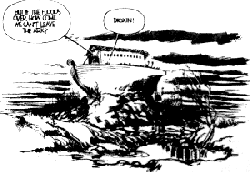
We felt our world was full of poison. |
land . . . but found that instead of the flood having
cleansed the world, it had left it full of poison! In
actuality, America was much less polluted in the 1980s
than in the 1960s and early 1970s, due to the dramatic
effects of hundreds of recent environmental programs. Yet
the press now suddenly discovered that our environment
was being polluted beyond anything we had yet
experienced, and a full media blitz, complete with scare
headlines and TV specials, focused on the remaining
problem areas. All of America seemed like a "HOUSE
THAT DIED OF POISON," as the Daily News phrased it,
as hundreds of reporters were sent out to find any
"poison" story which might allow them to
reflect our internal emotions.
|
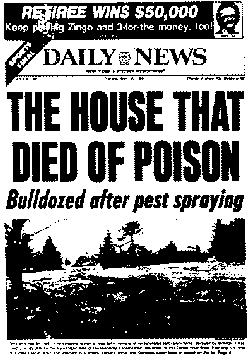
"The House That Died of Poison" |
In only one sense did these stories have some
relation to reality. It was true that the Reagan
administration - hoping to make the environment match
their own feelings of sinful pollutionhad attempted to
reverse many of the government's recent environmental
programs. As Ralph Nader put it, "They want to kill
everything off. They want to destroy the OSHA
[Occupational Safety and Health Administration], auto
safety, environmental health . . . within two years,
they'll be known as the Cancer Party."(36) Even so,
most of Reagan's "deregulation" efforts were
only partly effective, the environment as a whole
remained far less polluted than before, and such
continuing problems as dioxin, nuclear waste and acid
rain were all that remained to convey our paranoid
feelings of being poisoned from within. Headlines reading
"THE ENEMY BELOW"(37) and "NEW |
| DIOXIN 'HOT SPOT' IS DISCOVERED"(38) were merged
in our minds with others showing global maps of "THE
WORLD'S HOT SPOTS" (places of armed conflict), until
we hardly knew from one page. to the next if the
dangerous "hot spots" (sexuality) were inside
us (THE ENEMY BELOW), around us (DIOXIN HOT SPOT) or
overseas (WORLD'S HOT SPOTS). The American Medical
Associa-tion, reacting to such scare headlines as
"TOXIC CHEMICAL ALL AROUND US, SCIENTISTS SAY,"
finally issued a statement saying that "experts have
yet to document a single death" from dioxin,
pointing out that "the news media has made dioxin
the focus of a witch hunt by disseminating rumors,
hearsay and unconfirmed, unscientific reports" which
generated "unjustified public fright and
hysteria."(41) "Hysteria" it indeed was.
But mere scientific statements could not change our
deepest feelings. We needed something to dramatize our
conviction that we were being poisoned by too much
pleasure. Something like herpes, but far more deadly.
|
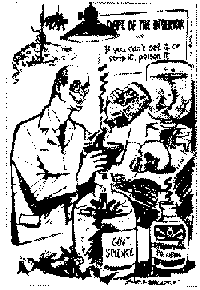
James Watt was felt to be poisoning us. |
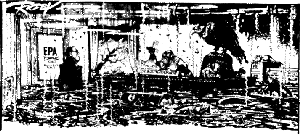
The government was seen awash in poison.
For a time, we played with the hope that we could objectify
these feel-ings by running stories of the "chemical
castration" of rapists, where judges for the first time
tried giving rapists the choice between long jail terms and
injections of Depo-Provera, which supposedly lowered their sexual
desires.(42) Yet even though this news story linked the
"poisonous" injections to punishment for sex, it was
too limited in scope to make a really powerful group-fantasy.
What we needed was something felt to be all around us, something
we all could get, something that could be direct-ly seen as a
punishment for sexual excess. What we needed was an anti-sexual
epidemic.
126

We felt we had a poison blood epidemic. |
The epidemic we found was AIDS, the usually fatal
Acquired Immune Deficien-cy Syndrome. Not only was AIDS
mysterious, without a known cause, but it mainly affected
"promiscuous homosex-uals," which the New Right
had been warning since Reagan's election would be the
cause of terrible disasters for America. The problem was,
explained the National Review, that homosexuals had
recently broken their pact with all of us to stay out of
sight and not stir up our homosexual feelings.
"Homosexuals committed to fighting openly for their
civil liberties are asking for it," they said.(43)
Homosexuals who dared to demonstrate for more help for
AIDS victims soon found themselves faced with
anti-homosexual counter-demonstrations, with frightened,
angry people carrying signs saying "DON'T DESTROY
AMERICA WITH YOUR LUST." Soon the fantasy that AIDS
was contracted from "contaminated blood" spread
around the country,(44) reaching the deepest fear anyone
can have, a fear which goes all the way back to the time
in the womb when each of us was actually poisoned from
time to time by the inability of our own placenta to
cleanse the waste in our bloodstream .(45) |
The "poison blood" group-fantasy was so frightening
that hospital workers refused to touch the "poisonous"
blood of AIDS victims, medical technicians began us-ing gloves
when touching anyone who was bleeding, equipment touched by
homosexuals was thrown away, morticians refused to bury AIDS
vic-tims, and blood donations dropped off dangerously due to
fears of "in-fected needles."(46) In local meetings all
across the country, homosexuals were denounced publicly as
"rapists . . sinners and liars," people who held orgies
in sex clubs," people who "because of AIDS"
endangered everyone in the community.(47) "A lot of people
feel that gays have gotten what they deserve," one worker
told a New York Times reporter. "On a bulletin board next to
him was a cartoon of a middle-aged woman airing her view on AIDS:
'Good Christian people have nothing to fear as long as we stay a
million miles away from the slimy creatures who may have it.'
"(49)
In fact, what "a lot of people" really felt was that
gays had gotten what we deserved: an anti-sexual epidemic, a
plague sent by God to punish us all for such things as the
sexually explicit cable TV programs watched in millions of
American homes.(49) "AIDS may mean the party
is over," mused Newsweek, expressing our feelings by
citing an anonymous homosexual as saying, "Maybe we are
wrong-maybe this is a punishment."(50)
By February 1983, the Great Reagan Poison Alert reached its
climax. Carter's "collapse" phase had peaked during the
summer of 1979, with images of disintegration, strangulation and
death. Reagan's "collapse" phase peaked six months
earlier in his term, with images of disintegration, disease and
poisoned blood. Carter had responded to our distress by arranging
for hostages to be taken in Teheran, giving us an external
enemy" to blame for our malaise. Reagan, however, seemed to
be dragging his feet. When would he find us an enemy? We couldn't
take all those free-floating poisoning fears indefinitely without
having someone to blame them on.
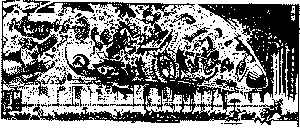
Reagan's "collapse" phase was dominated by
images of disintegration and death.
| The first to call Reagan to account on his broken
promise to find us an enemy was the Right. William
Safire, in a column headed "REAGAN'S WHITE
FLAG," told his New York Times readers that the
President had surrendered his principles, "had
admitted failure and abandoned 'ideology.' "(51) The
Times itself echoed Safire and editorialized that
"The stench of failure hangs over Ronald Reagan's
White House."(52) Some columnists tried to reassure
their readers that "Reagan is not another Carter. He
is tough. He is a leader."(53) Yet polls showed
Reagan's popularity had dropped to 10 points lower than
even Carter's at midterm, lower than any president in
American history at this point. John Lofton, in The
Washington Times, felt Reagan was so impotent that he was
not a man at all, but a dreaded woman, a "political
'Tootsie'. . . wearing clothes quite frankly . . . I was
unaware |
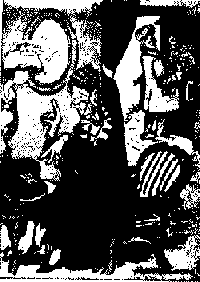
Reagan was taunted with being a woman for not
giving us an enemy to fight. |
128
were in his wardrobe. . . he is now decked out. . . in a big
floppy hat, a skirt, high heels, wearing bright red lipstick and
carrying a purse."(54) It was time to show Reagan that the
American people were more belligerent than he was.
Public opinion pollsters had earlier interviewed people on how
willing they were to go to war. Under headlines such as
"AMERICANS WILL-ING TO FIGHT, PROUD OF U.S.," they
reported: "In case of war, 71 percent of the Americans said
they would fight for their country," ap-parently regardless
of where the war was fought, since that was not part of the
question.(55) The message to Reagan was obvious. Even women
reporters told Reagan they were more ready to go to war than he
was. In Reagan's January 5th press conference, one woman reporter
stood up and asked him a question about whether women might
"go to war with the troops." Reagan was taken aback,
and, confused, replied, "Sarah, I have to say that there's
only one criteria, and that is if we're going to ask an American
young man or woman - but I don't think we'll put the young women
in those combat front ranks." Sarah shouted back at him:
"WE'RE READY!" The whole press room roared with relief
as she voiced our national plea.
By February, with Reagan still negligent in designating an
enemy for us, the American press produced the greatest outpouring
of "go to war" imagery that had been seen since just
before Vietnam. Since most of the world was at peace, the words
"DECLARE WAR" had to be hidden in whatever guise was at
hand, producing such headlines as these:
A DECLARATION OF WAR (Common Cause ad)
REAGAN SHOULD COME OUT SHOOTING (Patrick
Buchanan column)
IT'S WAR! ARMY VS. ROACH (Daily News)
FARMERS DECLARE WAR (New York Post)
RON TO CHURCH: DECLARE WAR ON NUKE FOES (New
York Post)
DISTRICT DECLARES WAR ON RABIES (Washington
Post)
IS WORLD ON BRINK OF TRADE WAR?
(U.S. News)
THE WAR FOR CHINATOWN (New York)
IT LOOKS LIKE WAR AT THE PEACE CORPS (Jack
Anderson column)
THE WAR OF WORDS ON EUROMISSILES (Dady News)
PREZ GOES TO WAR FOR DEFENSE BUDGET (New
York Post)
ARMY BEEFS UP WAR ON FATTIES (New York Post)
THE WAR ON KIDNEY STONES (Daily News)
OIL PRICE WAR (Daily News)
THE COMING TAX WAR (Joseph
Kraft column)
FEBRUARY 1983
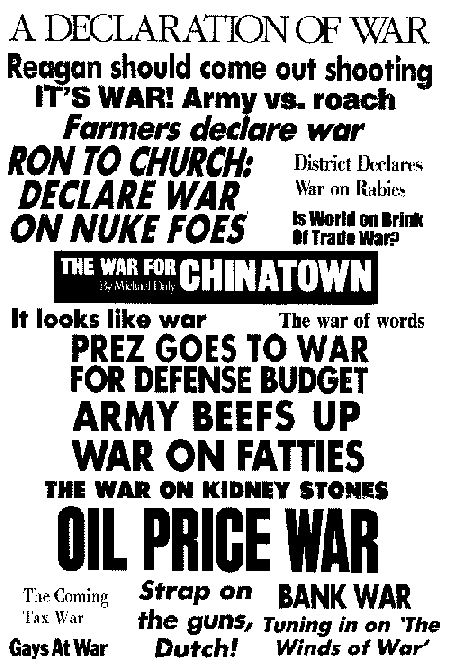
130
GAYS AT WAR (Mother Jones)
STRAP ON THE GUNS, DUTCH! (Patrick Buchanan
column)
BANK WAR ON INTEREST WITHHOLDING (Maxwell
Newton column)
TUNING IN ON 'THE WINDS OF WAR'
(New York Post)
WAR INSIDE CITY COUNCIL (Atlantic City)
REAGAN DECLARES WAR ON THE MOB (New York
Post)
THE WINDS OF WAR (People)
PREZ PLANS TV BLITZ IN FEDERAL WAGE WAR (New
York Post)
DRUNK-DRIVER WAR SHIFTING INTO HIGH (Daily
News)
WAR OF SECRETS (Wflliam Safire column)
YES, UNCLE SAM MUST LEAD THE WAR ON DRUGS
(Letter to the Editor)
BLOODLESS BUT BITTER NEW WAR BETWEEN THE
STATES (Des Moines Sunday Register)
POLS GO TO WAR IN SCHOOL BOARD ELECTIONS
(New York Post)
PREVENTION BATTLE CRY OF MDs IN WAR AGAINST
ALCOHOLISM (Clinical Psychiatry News)
MUGGERS DECLARE WAR ON ANGELS (New York
Post)
THE RISING TIDES OF WAR (Time)
ALL-OUT WAR DECLARED ON MIDTOWN PARKERS (New
York Post)
Reagan could no longer mistake the urgency of our demand. He
would have to find us an enemy and prepare for war so we could
shift the poison abroad.
Not that he liked being pushed into it, At his February 16th
press con-ference, one of the reporters asked him what his
reaction was to the recent rumor that "his aides" were
pushing him into decisions lately. "Well, I'll tell
you," he replied, angrily, "I read those things, too,
and I get pretty frustrated, because - - maybe I'm going to have
to have an exhibition up here in which we get some of those
unnamed aides up and see if they can push me off the platform!
I'm not being pushed around . . . there's no one pushing me . . .
"
Our pushing, nevertheless, worked. Reagan gave three dramatic
speeches in March to announce [1] why we had to go to war (the
March 8th "Evil Empire" speech), [2] whom we would have
to invade (the March 11th "Central America" speech) and
[3] how we would handle the guilt for our invasion (the March
23rd "Star Wars" speech.)
The "Evil Empire" speech was purely religious,
labeled "Reagan in the Pulpit" by The New York Times.
56 In it, he told us that "there is sin and evil in the
world, and we are enjoined by Scripture and our Lord Jesus to
oppose it with all our might." After confusing the voice of
the press with the voice of Jesus Christ, he then went on to
confuse himself with the enemy. He cited C. S. Lewis:
It was C. S. Lewis who, in his unforgettable Screwtape
Letters wrote:
"The greatest evil is not now done in those sordid
'dens of crime' that Dickens loved to paint . . . it is
conceived and ordered (moved, seconded, carried, and minuted)
in clear, carpeted, warmed, and well-lighted offices by quiet
men with white collars and cut fingernails and smooth-shaven
cheeks who do not need to raise their voice.
Because these "quiet men" do not "raise
their voices," because they sometimes speak in soothing
tones of brotherhood and peace, [we are tempted to] ignore
the facts of history and the aggressive impulses of an evil
empire .
What Reagan was here describing was what he felt himself,
sitting in his own "carpeted, warmed and well-lighted
office," with his "white collar and cut
fingernails," having to announce "without raising his
voice" that we had to go to waror, as he put it, had to
"oppose evil with all our might." He had known all
during his life-long crusade that this terrible moment must come.
Though the world seemed quiet, it was all deception. It was time
to act out "the struggle between right and wrong, good and
evil," he said. It was time to fight the Evil Empire.
Reagan's second speech, on Central America, began by
describing how the Soviets were now using Grenada, Cuba and
Nicaragua as bases. This was the cause of the trouble in Central
America and the Caribbean, he said, and now we were forced to
step in and stop their growing threat. Having set up the
immediacy of the danger, he then announced to the American people
that we would eventually have to send combat troops to the area .
. . announced it, that is, in the time-honored code Presidents
use in announcing such things to the American people:
Are we going to send American soldiers into combat? The
answer is a flat no.. . Are we going to Americanize the war
with a lot of U.S. combat advisors? Again the answer is no.
The effect was the same as when Lyndon Johnson stood before us
and repeated over and over again that "no American combat
troops would be sent to Vietnam." We knew the real meaning
of the message, as clearly as the child knows what's really going
on when daddy brings his pistol
132
up from the basement, loads it and tells him he is nor going
to use it to shoot mommy. Shortly later, when asked about sending
American troops, Reagan would change the "flat no" to
"the President should never say never." Nevertheless,
even then, on March 11th, we knew what he meant.
The March 23rd "Star Wars" speech was Reagan's
masterpiece. It would be cited by the media hundreds of times in
the coming months as the turning point in his foreign policy. The
speech had two aims. It had to show that the Evil Empire was very
close and was growing more dangerous by the minute, and it had to
make us feel that if we got into war once again we would be safe
from nuclear retribution.
The speech opened with Reagan's dramatic announcement that
"I have reached a decision . . . a very important decision .
. . to make America strong again. . ." While we had been
neglecting our military, he explained, the Soviets had been
producing twice as many combat aircraft, three times as many
attack submarines, five times as many tanks, fourteen times as
many artillery, and so on. Where had the Soviets put all these
dangerous new weapons? Reagan brought out a series of giant,
in-distinct photographs. Look, the poisonous weapons were right
there. . . he pointed to the photos . . . "in Western Cuba,
we see this military air-field" . . . another photo showed
"Soviet military hardware that has made its way to Central
America'' . . . a third showed "on the small island of
Grenada . . . an airfield with a 10,000-foot runway. Grenada
doesn't even have an air force. Who is it intended for?"
Reagan paused dramatically. It seemed obvious that the airport
was dangerous to us. Overlooked for the moment was the fact that,
according to Aviation Weekly and the British firm which designed
it, it was only good for tourist planes, lacking the
"facilities that would be needed for it to operate as a
military base including such military requisites as underground
fuel facilities, navigational and surveillance radar, underground
weapons storage, parallel taxiways or dispersal sites and
workshop and storage facilities for anything other than light
twin-engine aircraft."(57) It must be dangerous, we felt, as
we squinted at the dark photo flickering on our TV screen, like
an inkblot into which we could project our fears. The poison
seemed very close to us (even though Grenada was 1,500 miles from
the tip of Florida.) Some of us had even vacationed at one of
those "pleasure islands" in the Caribbean. We would
have to keep a careful eye on Grenada. Small as it was, it was
one of the "hot spots" - rather like dioxin, seemingly
innocent, but working silently to poison us.
The second purpose of the "Star Wars"
speech-promising an impregnable defense against a nuclear
holocaust-appears at first glance to have little connection with
Grenada and Central America, since these areas did not have
nuclear weapons even if we should invade them. Yet, in the
unconscious, Reagan's "Star Wars" fantasy of a screen
around
| the U.S. which could stop all missiles made sense to
us. We were, after all, planning to kill our persecutors.
Like a paranoid individual who decides to attack his
persecutors, we needed a fantasy that would pro-tect us
from retribution. Paranoid individuals sometimes
hallucinate a "magic bubble" or a "plastic
shield" which they think able to sur-round them,
protect-mg them from their im-agined enemies. Reagan
promised us that "we could intercept and destroy
strategic ballistic missiles before they reach our own
soil [and] give us the means of rendering these nuclear
weapons impotent and ob-solete." Imagine, being able
to render the Soviets impotent. "Isn't it worth
every investment," he asked excitedly. "We know
it is!" |
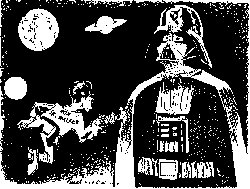
Reagan announced a Star Wars plan for fighting
the enemy. |
The "Star Wars" defense bubble idea, with its lasers
and space sta-tions and millisecond response time, had been
kicking around the Pen-tagon for years without finding a backer.
Carter's space weapons chief, Col. Robert M. Bowman, called it
"the ultimate military lunacy, easily overwhelmed and
vulnerable," which would give the nuclear holocaust "a
hair-trigger of milliseconds."(58) Although Reagan said in
his speech that his "very big decision" had been made
"after careful consultation with my advisors, including the
Joint Chiefs of staff," his own military hated the plan, and
leaked a story the next day to The Washington Post which reported
that the idea was Reagan's alone, and that he had
"per-sonally overruled objections from top Pentagon
officials when he an-nounced [it.]"59 Yet in the end it was
the emotional function of the defense shield that mattered, not
the scientific facts. We were feeling so crazy by then we had to
have an invulnerable shield. Let the scientists call it
"insane," which they did.(60) Let experts say, like
MIT's George Rath-jens, that "the president - I hate to say
this - on this issue is out of touch with reality."(61) Let
people point out it would be destabilizing to the ex-treme, and
that before long "the earth itself will have been turned
into a gigantic orbiting bomb."(62) By now, most Americans
were as out of touch with reality as Reagan. We needed this
"space bubble" fantasy if we were to go to war. Reagan
had, after all, made his "very big decision" to
announce the "space shield" plan at the same moment he
134
made his decision to oppose the Evil Empire. Both the
defensive and the aggressive fantasies were inexorably linked
together.
The emotional effects of these three speeches were electric.
Reagan's sagging polls soared. Re proudly proclaimed two days
later that "a dark cloud had been lifted" from
America.(63) The Great Reagan Poison Alert ended. Any further
poison episodes-such as the 10 people killed by the sedative
Zomax, which was made by the same firm as Tylenol-were now
relegated to the back pages of newspapers.(64) Cartoonists
stopped portraying the government as a poisoner. The "poison
in our bloodstream" had all been dumped into Central
America. Whereas in February, magazines showed a poisonous
serpent in the womb of the earth, beneath our cities, in March
they showed the same poisonous serpents in Central America.
Reagan had finally given us our enemy.
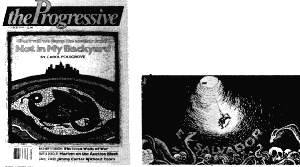
In February, the poisonous serpent was beneath
us, but in March, after Reagan's speech, it was shown in
Central America.
Soon the State Department began referring to the Nicaragua
desk as the "Get Nicaragua Desk." A major new
group-fantasy began to be elaborated that "a brown
horde" of Latins were about to flood into the U.S. Reagan
called it "a tidal wave of refugees," a fantasy
identical to that of Roosevelt when he feared the "undiluted
poison" which might pour into America from European
refugees.(65) The images of poison in Central America took varied
forms. Nicaragua was called "the tip of the tentacles of the
poisonous Soviet octopus" or "a poison spider crawling
up our leg," and Central America was seen to be
"hemorrhaging people into the United States,"(66) Even
though refugee immigration was only one-third what it had been
before Reagan was president. The "poison
| DUMPED THE POISON ABROAD |
135 |
| in our bloodstream" wasn't coming from
homosexuals after all, but from countries below us. For
a while, we actually felt much better for having dumped
the poison abroad. We were like Frosch's patient, who
felt better for a while after his "discovery"
that his vague internal poisoning fears were due to a
worldwide poisoning conspiracy. Our paranoid fears,
however, would soon return. Delusional solutions usually
break down when supposed "enemies" become so
threatening in our im-agination that they have to be
annihilated.
|
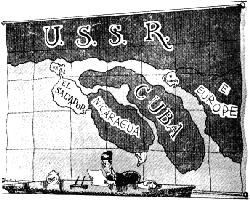
We felt we had dumped our poison into Nicaragua,
Cuba and the USSR, making them bloated and threatening. |
It would not be long before we would have to take action
against the Evil Empire of our waking dreams.
To report errors in this electronic
transcription please contact:
[email protected]










